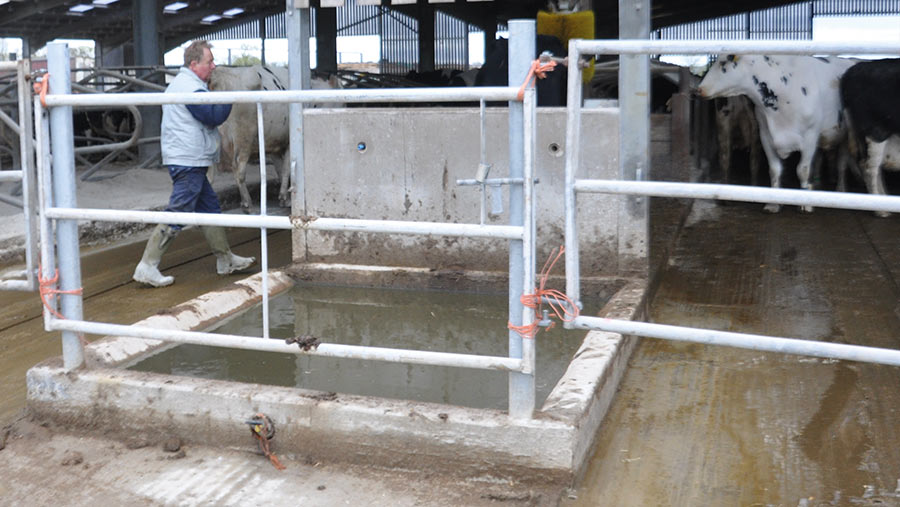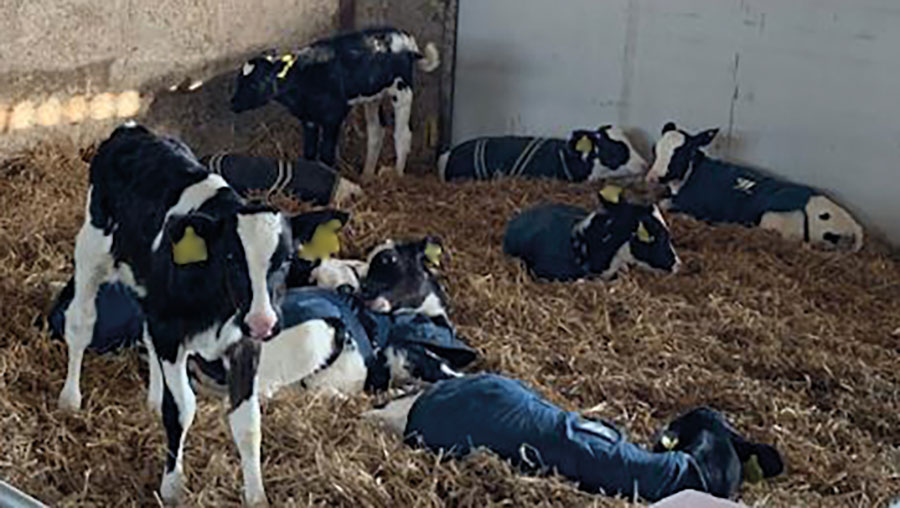Top tips to limit digital dermatitis in heifers
 © Roger Blowey
© Roger Blowey Many UK farms have worked hard to control digital dermatitis (DD) in their herds, but a range of steps could be used in heifer management to reduce rates further.
This is according to Gloucestershire-based cattle vet Roger Blowey, a long-term advocate of daily or twice-daily foot-bathing to control DD in heifers and cows.
Mr Blowey says major investment in controlling DD in the lactating herd can be threatened if replacement heifers are a Trojan horse of infection.
We get top tips on implementing management measures to control infection and how the Poole family, Sacksfield farm dealt with the problem
See also: How to disinfect foot trimming knives to reduce digital dermatitis
Stress point
When heifers are put under the stress of calving, this can be a point when latent DD lesions flare up, posing a threat to other animals and leading to non-healing lesions such as sole ulcers and white line disease.
This is due to a period of immune suppression, which can also cause issues such as mastitis, as heifers undergo the stresses of calving, social change, new surroundings and producing high volumes of milk.
Mr Blowey suggests a range of management measures farms can try to limit infection in heifers.
1. Foot-baths
- Daily foot-bathing can help control and combat DD
- The chemical and concentration used will vary according to the farm and the severity of infection. Formalin is a very successful foot-bath chemical on many farms and, with its licence extended, looks likely to be available in the short to medium term
- Daily foot-bathing of heifers should start as soon as DD is first seen. If this is at six months old, start foot-bathing then
- If heifer rearing is outsourced, investigate conditions on the farm, look at the possibilities of fitting a foot-bath and improve general foot hygiene

© Roger Blowey
2. Check internal biosecurity
- Any shared kit such as scraper tractors and yard scrapers used in heifer, dry cow and milking cow accommodation could be a route for transmission. Washing them down with water or limiting shared equipment could help
- A Defra-approved boot dip and brush used in the heifer shed can help limit the passage of DD from adult stock to youngstock
- These measures will also help with Johne’s disease control
3. Maintain farm biosecurity
- For flying herds that buy in replacements close to calving, foot-bathing incoming heifers twice a day for a week can help limit the spread of infection and familiarise heifers with the foot-bath
- Inspecting feet on arrival and installing a foot-bath in the heifer shed are inexpensive measures to get on top of DD, which can be a very a costly disease
4. Regular pen walks
- Look at the back of the foot for lesions when checking groups for comfort, condition or bulling
- Understanding the infection pressure on the farm in heifers is most accurately done by lifting feet, but this is laborious and often only happens at the six-week-calved and dry-off foot-trim
5. Regular parlour audit
- An easy option is to check fresh heifers in the parlour to see if they are calving in with DD
- If the parlour is dark, take a torch and conduct a post-calving check on heifers – look for any abnormal skin at the back of the hoof
- The skin at the skin/horn border should be smooth, supple and bendable
- Ask your vet to familiarise you with the M-stage lesions of DD
Other considerations
- Nutrition Talking to a nutritionist about heifer-rearing diets and inspecting dung can help pinpoint how to limit runny dung and help hygiene. The DD treponemes live in slurry and thrive in damp environments, so clean and dry feet don’t succumb to DD as easily as wet and unclean hooves
- Minerals Talk to your nutritionist about feeding to promote healthy hoof growth. Studies have shown hoof strength can be boosted with vitamins A, C, D and E; iodine; calcium; combinations of zinc and biotin; and zinc manganese, copper and biotin
- Blood test As an extra precaution, blood testing can be used to identify treponemal antibodies in heifers as young as three to four months old, although it’s mainly a research tool
Case study: Poole family, Sacksfield Farm, Staunton
Focusing on heifer management and hoof cleanliness from birth to calving is allowing a Gloucestershire dairy to control DD through a challenging loose-housed period.
The Poole family of Sacksfield farm, Staunton, used to see 35-40% of the herd affected by DD at any one time back in 2010. Now DD affects just 2-3% of cows annually.
Considering the heifer rearing stage as a possible risk of disease and taking steps to monitor and prevent it has helped avoid any major flare-ups since 2018. White line disease is now the main lameness problem – affecting about 6% of the herd annually.
Sacksfield Farm facts
- 300 Holstein-Friesian cows plus followers on 240ha (595 acres), of which 38ha (95 acres) is rented
- 98ha (240 acres) of maize and grass silage in multicut forage-box system
- Averages 30 litres a cow a day at 4.2% fat and 3.8% protein
- Supplies Cotteswold Dairy
- All calves reared and beef sold to Foyles or Pickstocks

Heifer replacements are reared on a milk machine and given ad-lib milk until 35 days old © Mark Poole
Seven ways Sacksfield Farm manages DD in heifers
- Foot-bathing At 10 months old, heifers are moved into a cubicle shed with locking yokes and a foot-bath. Heifers are fed twice a day and gates are shut off in passageways. The only way back to the cubicles is via a 2m-wide foot-bath with a 6% formalin solution (3% for milking herd). Dry cows are also foot-bathed. This happens every day, barring Sunday.
- Pen checks Everybody checks the feet of heifers when they are pushing up food – four times a day.
- WhatsApp group A group chat between the family and the four full-time staff members is used to report treatments, foot spraying and any potential lesions and other issues throughout the herd. Pictures of animals and freeze brands or ear tags are used to identify individuals quickly.
- Spraying If lesions are seen on the back of the hoof, blue alamycin spray (a licensed antibiotic) is used and a dose of a non-steroidal anti-inflammatory drug is given. About 10-15% of heifers have their feet picked up because of DD.
- Parlour audits Vets from Wood Veterinary Group check feet four to five times a year in the parlour.
- Isolation Next to the crush there is a shed split into two 4.5m bays. These are used as sick bays for lame/ill cows. The hoof-trimmer treats the DD and the hoof is lifted two to three times until the lesion scabs and dries up and the cow is allowed to re-enter its group.
- Nutrition Copper and manganese is included in the mineral blend of the total mixed ration, partly to promote strong hoof growth.
Future improvements
Pen checks confirmed the farm has a weak point in the heifer-rearing system.
Calves are reared on a milk machine and given as much milk as they can take for 35 days, with milk restricted thereafter and calves weaned at 56-60 days, when they go into larger groups and eventually into loose-housed, straw-bedded sheds with concrete feeding areas.
Heifers are housed like this from about 12 weeks to 10 months old. A daily load-all scrape keeps the flooring clean, but it can’t get around internal water troughs and there is no foot-bath to keep feet clean, so a build-up of slurry leads to damp hooves.
“That three- to 10-month period is when we have trouble with replacements getting DD,” says Mr Poole.
Heifer rearing is so important to the Pooles that they are considering building a new cubicle shed with automatic scrapers to address this weakness.
“At about £100,000 or more it sounds a big investment, but trying to improve things is the enjoyable part of farming. It would certainly address a weak point in the system.”
